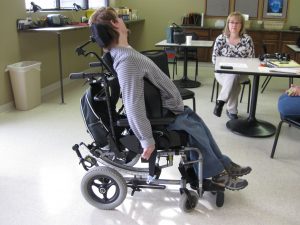Using Dynamic Seating To Diffuse Force And Reduce Overall Extension
 Michelle L. Lange, OTR/L, ATP/SMS
Michelle L. Lange, OTR/L, ATP/SMS
Updated 11/11/2024
As discussed in our last 2 blogs, Dynamic Seating is commonly used to prevent breakage of the wheelchair seating system and frame. Another common application of dynamic seating is to diffuse force and reduce overall extension.
Many clients using wheelchair seating have increased muscle tone. This can lead to active extension, particularly at the hips, knees, and neck. When a client extends against a static seating system, the forces exerted against the footplates, seat, back, and head support have nowhere to go and this can lead to an actual increase in client extension. Spasticity increases with resistance, such as client forces exerted against a non-yielding surface (Bar-On, et al., 2018). This force can be significant. One study found that clients with increased extension were able to exert up to 200% of their body weight against the back support and up to 600% of their body weight against the foot supports during extension (Samaneein, et al., 2013). It is no wonder that the client may have difficulty tolerating the seating system for a reasonable amount of time (sitting tolerance), and may experience discomfort and even pain.
Dynamic Seating absorbs and diffuses these extensor forces. Remarkably, this can lead to an actual reduction in extensor tone. Think about it this way. Perhaps you have sat behind a client on a mat table or couch who is actively extending. If you try and resist this extension, the client may push harder. If you allow the client to extend, however, and then assist them to return to upright, the client relaxes. I have observed a number of clients who spent much of their day “fighting” their static seating system, who were able to tolerate that same seat with Dynamic Seating.
Research confirms these statements:
- Dynamic Seating decreased extensor thrust (Cimolin, et al., 2009).
- Dynamic Seating decreased extension patterns (Lange, 2021).
Watch our Quick Class on Absorbing and Diffusing Force to learn more.
